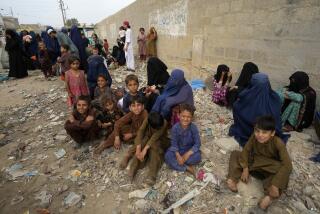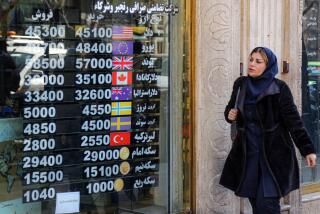Iran Sees Need for Refugee Aid Waning Like Taliban
- Share via
TEHRAN — The Taliban is on the decline, and so is Iran’s need to build new camps for refugees, the government’s top official on Afghan issues says, in a policy shift that the United Nations fears may be premature.
With much of Afghanistan’s border with Iran in the hands of the anti-Taliban Northern Alliance, the focus should be on sending food and supplies into the war-racked country, not drawing more refugees into his immigrant-weary nation, said Hassan Ali Ebrahimi, who heads the Interior Ministry’s department of Afghan affairs.
“If Herat falls, then there shouldn’t be a need to create camps because there won’t be any refugees coming to Iran,” said Ebrahimi, hours before the strategic city in western Afghanistan was captured Monday by the Northern Alliance. “Instead, people will go to Afghanistan.”
Unofficial estimates support that premise. Iran’s border with Afghanistan remains officially closed, but Afghans are being allowed to return home and are reportedly doing so at a rate of about 500 a day.
Yet at the same time, the larger of Iran’s two existing refugee camps inside Afghanistan has since Sunday been overrun by thousands more people than Iranian Red Crescent workers have been able to handle.
“The situation is still fluid in Afghanistan, and we still want to have contingency plans inside Iran or other countries for people seeking asylum,” Millicent Mutuli, a spokeswoman for the Office of the U.N. High Commissioner for Refugees in Tehran, said Monday.
Iran had planned to erect nine camps to house refugees from the current crisis. Instead it has built just two, and those have come under fire from the U.N. refugee agency for being in a war zone and thus threatening the safety of refugees as well as aid workers.
The two camps are a few miles inside Afghanistan near the city of Zaranj. Iranian officials say the first, called Mille 46 after an Iranian border marker, recently reported having more than 900 refugees, while the second, Mahkaki, reported about 8,000.
The U.N. refugee agency has refused to allow any of its workers to go to the camps. Iran, in turn, has resisted U.N. pressure to place new camps on Iranian land just inside the border.
Iran has two decades’ experience with Afghans coming into the country, Ebrahimi said. And most of the close to 2.6 million Afghan immigrants now here came for economic reasons, not safety, he said. The 1 million jobs they hold in Iran are enough to fuel the economy of a small country, he added.
“If we build more camps and advertise them, more will come,” Ebrahimi said. “They’ll come for a better life, not because they are refugees.”
Ebrahimi also criticized the lack of international help for Afghan refugee efforts undertaken by his country since the U.S. military campaign in Afghanistan began last month.
“All expenses are on the shoulders of Iran,” he said. “There is a lot of talk but no action.”
While they are still tabulating the cost, Ebrahimi said, Iranian aid organizations have already spent $500,000 on food and medicine for the refugees.
Mutuli acknowledged that Iran has shouldered the burden for millions of refugees in the last two decades. But “after the Sept. 11 events, much of the hesitation has been about the location” of the camps, she said. “The sites inside Afghanistan are not acceptable.”
More to Read
Sign up for Essential California
The most important California stories and recommendations in your inbox every morning.
You may occasionally receive promotional content from the Los Angeles Times.













